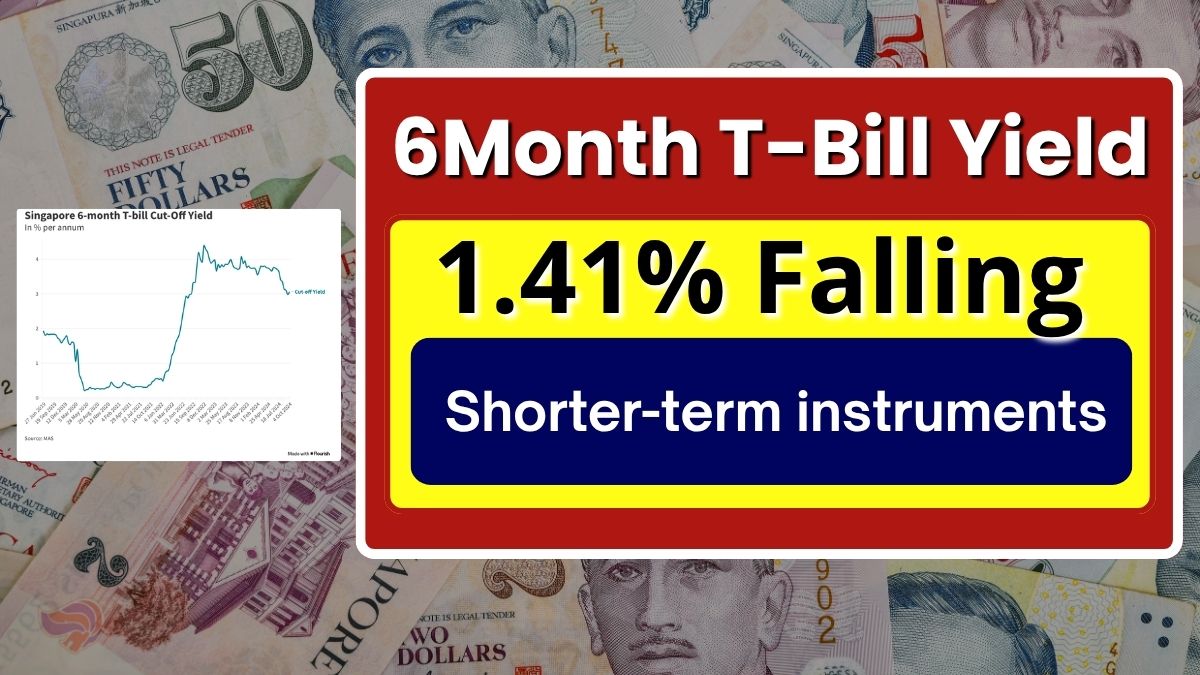If you’ve been following Singapore’s Treasury bill (T-bill) auctions, you might’ve noticed something interesting this week — the 6-month T-bill cut-off yield has edged down to 1.41%, slightly lower than the 1.44% seen in the last auction on Oct 9.
At first glance, that 0.03% drop might not seem like much. But here’s the thing: even small moves in T-bill yields can hint at broader market expectations — especially when global interest rates are shifting and investors are positioning for what’s next.
What Happened in the Latest Auction
According to the Monetary Authority of Singapore (MAS), the latest auction drew S$15.9 billion in applications for S$7.9 billion on offer — giving it a bid-to-cover ratio of 2.01, slightly stronger than the 1.9 ratio from the previous round.
That means demand for these short-term government securities remains strong, even as yields dip a little.
The median yield eased to 1.35% (from 1.38%), while the average yield stayed steady at 1.29%. All non-competitive bids were filled, totaling S$1.1 billion, and about 12% of competitive bids at the cut-off yield were accepted.
In short: investors are still eager to park their funds in safe, short-term assets — even at slightly lower returns.
Why the Singapore 6-Month T-Bill Yield Is Falling
Financial analysts say the lower yield reflects investor expectations of further U.S. Federal Reserve rate cuts before year-end.
DBS senior rates strategist Eugene Leow explained that while the Fed’s easing trend may nudge global yields lower, the “pass-through from Fed cuts to Singapore dollar rates should continue to be muted.”
Put simply, Singapore’s domestic rates are expected to stay stable — just not fall as quickly as U.S. rates.
Eastspring Investments’ portfolio manager Cheong Wei Ming added that continued global easing will likely keep Singapore dollar interest rates low and range-bound through the year-end period, helped by ample liquidity in the financial system.
And according to Frances Cheung, OCBC’s head of foreign exchange and rates strategy, the 1.41% yield aligns closely with short-end market rates, suggesting “healthy demand driven by strong liquidity.”
What This Means for Everyday Investors
If you’re a retail investor looking for a low-risk place to park extra cash, T-bills remain one of the most stable options in Singapore.
While the yields have softened, they still offer better returns than regular savings accounts — and with zero risk of default.
That said, if the U.S. rate cuts continue, T-bill yields may stay subdued for the next few months. Investors who value liquidity might prefer shorter-term instruments or laddering T-bill investments to manage reinvestment risk.
A Look Ahead
Singapore plans to issue up to S$450 billion more in government securities under its revised issuance limit of S$1.515 trillion, which extends until 2029. This suggests a continued pipeline of opportunities for conservative investors who favor safe, government-backed options.
So while the yield dip might seem disappointing, it also reflects a healthy, liquid market — one where investors still trust Singapore’s stability even when returns are modest.
Frequently Asked Questions
1. Why did the 6-month T-bill yield drop to 1.41%?
The yield fell slightly as investors expect further U.S. Fed rate cuts, leading to lower global yields. Strong demand for safe assets also contributes to the lower rate.
2. Is investing in T-bills still worthwhile?
Yes. Even with slightly lower returns, T-bills remain a secure option with higher yields than most bank deposits.
3. How often does MAS issue T-bills?
The Monetary Authority of Singapore typically auctions 6-month T-bills every two weeks, offering retail and institutional investors regular access to these instruments.
